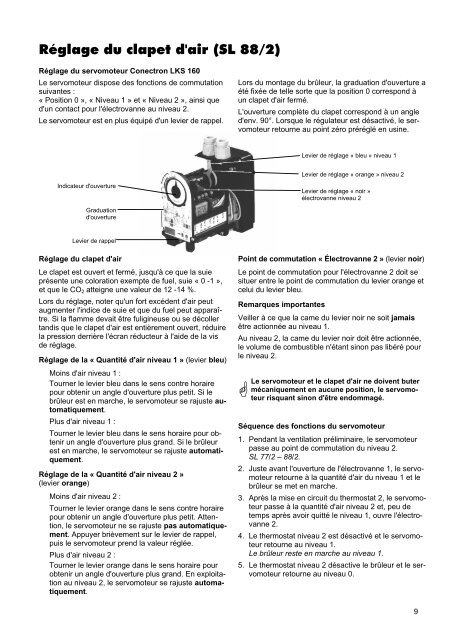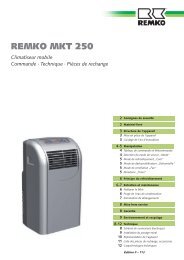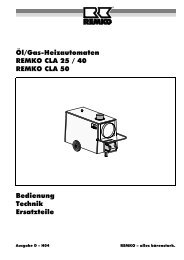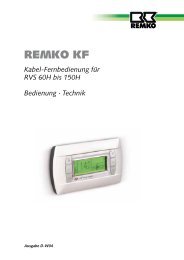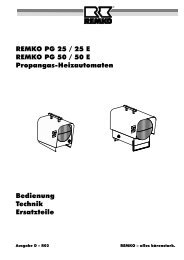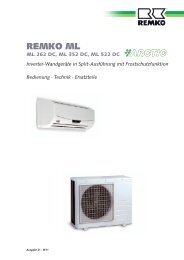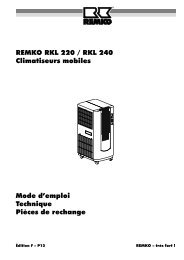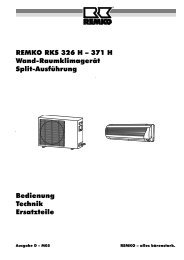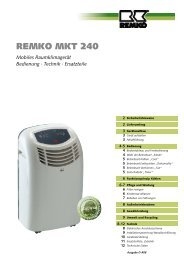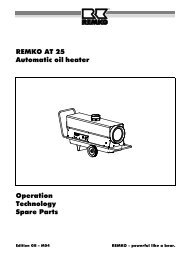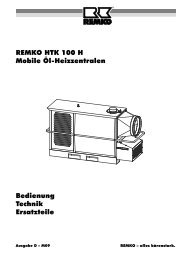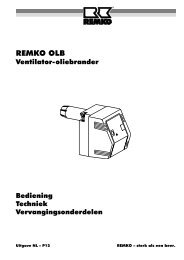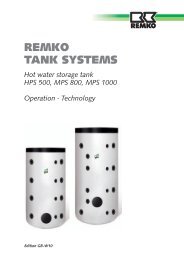Le servomoteur et le clapet d'air ne doivent buter - Remko
Le servomoteur et le clapet d'air ne doivent buter - Remko
Le servomoteur et le clapet d'air ne doivent buter - Remko
Create successful ePaper yourself
Turn your PDF publications into a flip-book with our unique Google optimized e-Paper software.
Réglage du clap<strong>et</strong> <strong>d'air</strong> (SL 88/2)<br />
Réglage du <strong>servomoteur</strong> Co<strong>ne</strong>ctron LKS 160<br />
<strong>Le</strong> <strong>servomoteur</strong> dispose des fonctions de commutation<br />
suivantes :<br />
« Position 0 », « Niveau 1 » <strong>et</strong> « Niveau 2 », ainsi que<br />
d'un contact pour l'é<strong>le</strong>ctrovan<strong>ne</strong> au niveau 2.<br />
<strong>Le</strong> <strong>servomoteur</strong> est en plus équipé d'un <strong>le</strong>vier de rappel.<br />
Indicateur d'ouverture<br />
Graduation<br />
d'ouverture<br />
<strong>Le</strong>vier de rappel<br />
Réglage du clap<strong>et</strong> <strong>d'air</strong><br />
<strong>Le</strong> clap<strong>et</strong> est ouvert <strong>et</strong> fermé, jusqu'à ce que la suie<br />
présente u<strong>ne</strong> coloration exempte de fuel, suie « 0 -1 »,<br />
<strong>et</strong> que <strong>le</strong> CO2 atteig<strong>ne</strong> u<strong>ne</strong> va<strong>le</strong>ur de 12 -14 %.<br />
Lors du réglage, noter qu'un fort excédent <strong>d'air</strong> peut<br />
augmenter l'indice de suie <strong>et</strong> que du fuel peut apparaître.<br />
Si la flamme devait être fuligi<strong>ne</strong>use ou se décol<strong>le</strong>r<br />
tandis que <strong>le</strong> clap<strong>et</strong> <strong>d'air</strong> est entièrement ouvert, réduire<br />
la pression derrière l'écran réducteur à l'aide de la vis<br />
de réglage.<br />
Réglage de la « Quantité <strong>d'air</strong> niveau 1 » (<strong>le</strong>vier b<strong>le</strong>u)<br />
Moins <strong>d'air</strong> niveau 1 :<br />
Tour<strong>ne</strong>r <strong>le</strong> <strong>le</strong>vier b<strong>le</strong>u dans <strong>le</strong> sens contre horaire<br />
pour obtenir un ang<strong>le</strong> d'ouverture plus p<strong>et</strong>it. Si <strong>le</strong><br />
brû<strong>le</strong>ur est en marche, <strong>le</strong> <strong>servomoteur</strong> se rajuste automatiquement.<br />
Plus <strong>d'air</strong> niveau 1 :<br />
Tour<strong>ne</strong>r <strong>le</strong> <strong>le</strong>vier b<strong>le</strong>u dans <strong>le</strong> sens horaire pour obtenir<br />
un ang<strong>le</strong> d'ouverture plus grand. Si <strong>le</strong> brû<strong>le</strong>ur<br />
est en marche, <strong>le</strong> <strong>servomoteur</strong> se rajuste automatiquement.<br />
Réglage de la « Quantité <strong>d'air</strong> niveau 2 »<br />
(<strong>le</strong>vier orange)<br />
Moins <strong>d'air</strong> niveau 2 :<br />
Tour<strong>ne</strong>r <strong>le</strong> <strong>le</strong>vier orange dans <strong>le</strong> sens contre horaire<br />
pour obtenir un ang<strong>le</strong> d'ouverture plus p<strong>et</strong>it. Attention,<br />
<strong>le</strong> <strong>servomoteur</strong> <strong>ne</strong> se rajuste pas automatiquement.<br />
Appuyer brièvement sur <strong>le</strong> <strong>le</strong>vier de rappel,<br />
puis <strong>le</strong> <strong>servomoteur</strong> prend la va<strong>le</strong>ur réglée.<br />
Plus <strong>d'air</strong> niveau 2 :<br />
Tour<strong>ne</strong>r <strong>le</strong> <strong>le</strong>vier orange dans <strong>le</strong> sens horaire pour<br />
obtenir un ang<strong>le</strong> d'ouverture plus grand. En exploitation<br />
au niveau 2, <strong>le</strong> <strong>servomoteur</strong> se rajuste automatiquement.<br />
Lors du montage du brû<strong>le</strong>ur, la graduation d'ouverture a<br />
été fixée de tel<strong>le</strong> sorte que la position 0 correspond à<br />
un clap<strong>et</strong> <strong>d'air</strong> fermé.<br />
L'ouverture complète du clap<strong>et</strong> correspond à un ang<strong>le</strong><br />
d'env. 90°. Lorsque <strong>le</strong> régulateur est désactivé, <strong>le</strong> <strong>servomoteur</strong><br />
r<strong>et</strong>our<strong>ne</strong> au point zéro préréglé en usi<strong>ne</strong>.<br />
�<br />
<strong>Le</strong>vier de réglage « b<strong>le</strong>u » niveau 1<br />
<strong>Le</strong>vier de réglage « orange » niveau 2<br />
<strong>Le</strong>vier de réglage « noir »<br />
é<strong>le</strong>ctrovan<strong>ne</strong> niveau 2<br />
Point de commutation « É<strong>le</strong>ctrovan<strong>ne</strong> 2 » (<strong>le</strong>vier noir)<br />
<strong>Le</strong> point de commutation pour l'é<strong>le</strong>ctrovan<strong>ne</strong> 2 doit se<br />
situer entre <strong>le</strong> point de commutation du <strong>le</strong>vier orange <strong>et</strong><br />
celui du <strong>le</strong>vier b<strong>le</strong>u.<br />
Remarques importantes<br />
Veil<strong>le</strong>r à ce que la came du <strong>le</strong>vier noir <strong>ne</strong> soit jamais<br />
être actionnée au niveau 1.<br />
Au niveau 2, la came du <strong>le</strong>vier noir doit être actionnée,<br />
<strong>le</strong> volume de combustib<strong>le</strong> n'étant sinon pas libéré pour<br />
<strong>le</strong> niveau 2.<br />
<strong>Le</strong> <strong>servomoteur</strong> <strong>et</strong> <strong>le</strong> clap<strong>et</strong> <strong>d'air</strong> <strong>ne</strong> <strong>doivent</strong> <strong>buter</strong><br />
mécaniquement en aucu<strong>ne</strong> position, <strong>le</strong> <strong>servomoteur</strong><br />
risquant sinon d'être endommagé.<br />
Séquence des fonctions du <strong>servomoteur</strong><br />
1. Pendant la ventilation préliminaire, <strong>le</strong> <strong>servomoteur</strong><br />
passe au point de commutation du niveau 2.<br />
SL 77/2 – 88/2.<br />
2. Juste avant l'ouverture de l'é<strong>le</strong>ctrovan<strong>ne</strong> 1, <strong>le</strong> <strong>servomoteur</strong><br />
r<strong>et</strong>our<strong>ne</strong> à la quantité <strong>d'air</strong> du niveau 1 <strong>et</strong> <strong>le</strong><br />
brû<strong>le</strong>ur se m<strong>et</strong> en marche.<br />
3. Après la mise en circuit du thermostat 2, <strong>le</strong> <strong>servomoteur</strong><br />
passe à la quantité <strong>d'air</strong> niveau 2 <strong>et</strong>, peu de<br />
temps après avoir quitté <strong>le</strong> niveau 1, ouvre l'é<strong>le</strong>ctrovan<strong>ne</strong><br />
2.<br />
4. <strong>Le</strong> thermostat niveau 2 est désactivé <strong>et</strong> <strong>le</strong> <strong>servomoteur</strong><br />
r<strong>et</strong>our<strong>ne</strong> au niveau 1.<br />
<strong>Le</strong> brû<strong>le</strong>ur reste en marche au niveau 1.<br />
5. <strong>Le</strong> thermostat niveau 2 désactive <strong>le</strong> brû<strong>le</strong>ur <strong>et</strong> <strong>le</strong> <strong>servomoteur</strong><br />
r<strong>et</strong>our<strong>ne</strong> au niveau 0.<br />
9


